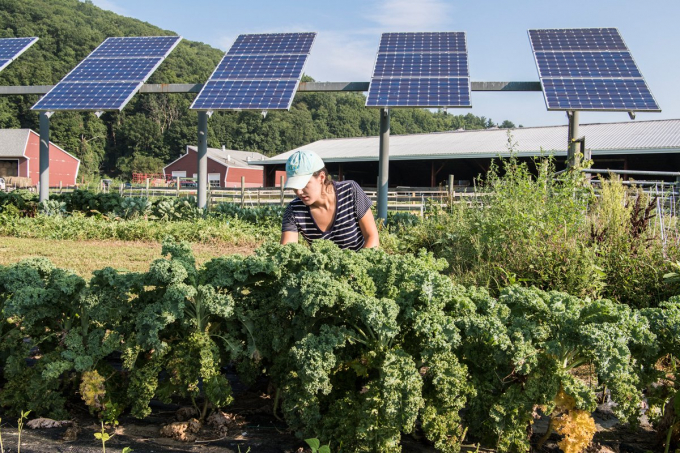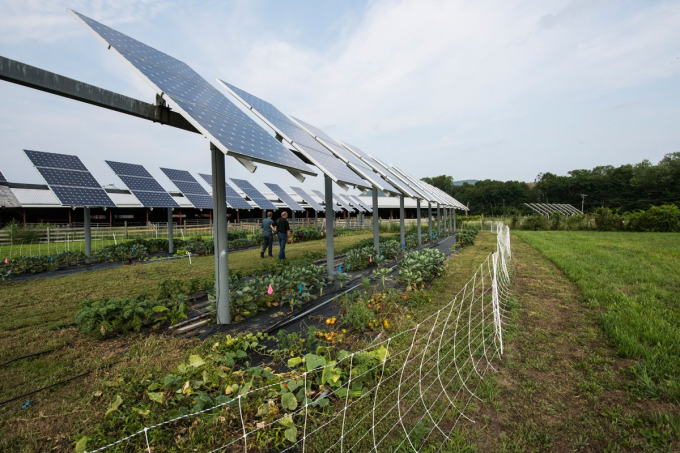November 26, 2025 | 04:42 GMT +7
November 26, 2025 | 04:42 GMT +7
Hotline: 0913.378.918
November 26, 2025 | 04:42 GMT +7
Hotline: 0913.378.918

Umass grad student Kristin Oleskwwicz harvests vegetables growing under PV arrays at a test plot at the UMass Crop Animal Research and Education Center in South Deerfield, Massachusetts. (Photo CC-licensed by the National Renewable Energy Laboratory)
Most Massachusetts residents agree on the urgent need to tackle the climate crisis. But when it comes to the question of solar development, they’re much less aligned. While some believe the state is blazing a trail for renewable energy infrastructure, others worry that the construction of new solar arrays throughout the state is accelerating the destruction of forests and farmland.
Despite its diminutive size and cool climate, Massachusetts ranks eighth in the nation for solar energy capacity. And unlike other leading states like Texas and Arizona, flat, open expanses are hard to come by in New England. As a result, to cash in on the state’s generous renewable energy incentives, some companies clear trees or take over cropland to build massive systems that place panels on the ground in long, compact rows.
In the sixth edition of Mass Audubon’s “Losing Ground” report, published last year, the conservation group estimated that 6,000 acres of solar accounted for about a quarter of the land lost to development in the state between 2012 and 2017. It calculated that if business continued as usual, another 150,000 acres would be developed just to meet the state’s energy goals by 2050. More recently, a team of researchers at Clark University used satellite data and machine learning to map solar development in the state and determined the number of acres cleared is likely already much higher, with about half in places that were formerly forest and about a quarter in former cropland.
Heidi Ricci, Massachusetts Audubon Society’s director of policy and advocacy, says that development peaked in 2016 and has gone down in recent years. However, she adds, “We are still seeing tremendously high rates of conversion on some sensitive lands, including prime farmland in the Connecticut Valley, large blocks of forests in Western Massachusetts, and the globally rare Pine Barrens down in southeastern Massachusetts.”
Ricci’s organization and other conservationists believe the tradeoffs of converting farms and forests—which can also hold carbon and provide various other ecosystem services—to solar are too great and that the state should more clearly incentivize placing solar on already developed sites such as rooftops, parking canopies, and brownfields. Clean-energy proponents say changes that restrict or slow solar development in any way will prolong dependence on fossil fuels, making the climate crisis worse. But a contingent that now has strong state support sees another path as a winning compromise: “dual-use” or “agrivoltaic” systems that allow farmers to continue to use the land beneath raised solar arrays for crops and livestock.
“The big impact that standard solar development is currently having on farmers and farmland is displacement,” said Drew Pierson, head of sustainability at BlueWave Solar, a Boston-based company leading the charge on dual-use development. In contrast, dual-use projects keep the land in farming and provide an additional revenue stream. “We are bringing financing and infrastructure to the table to hopefully decrease the production cost for farmers, so it’s easier for them to farm,” he said, adding that he believes advances in technology and design will make dual-use more efficient for both farmers and energy production in the near future.

NREL researchers Jordan Macknick and Paul Torcelini, and UMass professor Stephen Herbert survey the test plot at the UMass Crop Animal Research and Education Center in South Deerfield MA. (Photo CC-licensed by the National Renewable Energy Laboratory)
How all of this shakes out in Massachusetts could set the stage for how other states negotiate conflicts between forest and farmland conservationists and clean-energy proponents that are sure to arise as the climate crisis accelerates and the Biden administration acts to build up renewable infrastructure quickly.
Connecticut, for example, passed a new law in 2017 to make it harder for companies to build utility-scale solar projects on farmland after several controversial developments, while North Carolina, which ranks third nationally in solar production, does not disincentivize solar development on farmland at all.
Panels in the Pine Barrens
Development currently occurring in the Southeast corner of Massachusetts near Cape Cod illustrates why conservations are concerned.
In March, developer Borrego Solar Systems submitted an environmental notification form to the state’s Executive Office of Energy and Environmental Affairs detailing a cluster of three solar projects currently in development on sites in Wareham owned by AD Makepeace, the world’s largest cranberry grower and the state’s largest property owner. While AD Makepeace is an agricultural company, these projects are ground-mounted solar, not dual-use systems.
Combined, the projects will clear more than 150 acres of forest in the Coastal Pine Barrens region, in addition to several sites that AD Makepeace has already cleared and developed for solar ground-mount systems in surrounding towns. Meg Sheehan, an environmental lawyer and resident of nearby Plymouth, has been fighting the collection of projects with a coalition of local residents since 2016, some of whom recently filed a lawsuit to stop the Wareham developments.
The groups say that AD Makepeace and Borrego Solar are using the solar development process to remove trees and earth to feed AD Makepeace’s soil business while cashing in on renewable energy credits at the expense of the natural beauty, groundwater holding and filtration, and the biodiversity the forests support. “They’re disrupting the ecosystem in such an extreme way. Maybe we’ll have lots of solar and fewer fossil fuel emissions . . . but we won’t have a livable planet,” Sheehan said. AD Makepeace did not respond to requests for comment.
A spokesperson for Borrego Solar said that while the company does also install solar panels on already developed spaces like rooftops, “large, ground-mounted systems are necessary to scale up to meet climate goals and avert climate change.” The projects in Wareham, they said, will generate 60,315 megawatt-hours of electricity, enough energy to power more than 5,100 homes.
As to whether the company considers the impacts on biodiversity and ecosystems when clearing land for solar, the spokesperson said Borrego performs “considerable real estate, environmental, and historical due diligence on every site” in accordance with the law.
But land use laws often allow for the clearing of forests. And biodiversity loss is a global issue that has accelerated alongside the climate crisis in recent years. A 2019 United Nations report found diversity of native plant and animal life has fallen by an average of 20 percent or more around the world, mostly in the last century. Massachusetts is home to 432 native plant and animal species that are endangered. Government policies—including Massachusetts’ policies—often confront climate change and biodiversity as two separate issues. In early June, researchers on two leading international scientific panels concluded that neither problem can be addressed effectively if they are not tackled in tandem.
(Civileats.com)

(VAN) Brazil's COP30 presidency pushed through a compromise climate deal on Saturday that would boost finance for poor nations coping with global warming but that omitted any mention of the fossil fuels driving it.

(VAN) Poultry farmers in the UK have been warned that they could face one of the worst winters yet for bird flu.

(VAN) Prices of main-crop paddy have risen sharply, with jasmine rice hitting 16,100 baht per tonne — the highest level in years.

(VAN) In Brazil, FAO unveiled a series of reports and initiatives showing how sustainable agrifood systems are a solution to the climate crisis.

(VAN) With names like neodymium and dysprosium, rare-earth elements sound exotic — and their perceived scarcity has only added to the mystique.

(VAN) In a new study published in Trends in Biotechnology, researchers used a gene-editing technology called CRISPR to increase a fungus's production efficiency and cut its production-related environmental impact by as much as 61%- all without adding any foreign DNA.

(VAN) A top official in Beijing’s Cop delegation says China is committed to clean energy – but US’s absence is a problem.